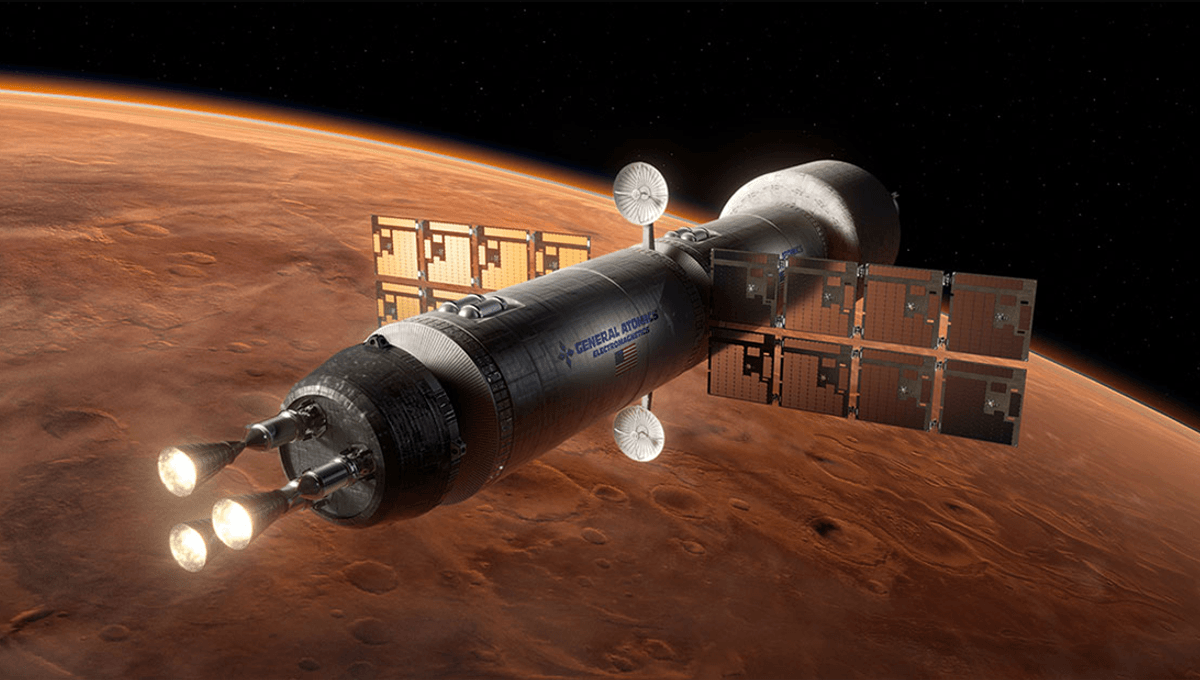
A new type of nuclear thermal propulsion reactor fuel has been successfully tested at NASA’s Marshall Space Flight Center, with hopes that the fuel could take humans to Mars in the not-too-distant future.
ADVERTISEMENT GO AD FREE
Getting to the Red Planet, as things currently stand, will be a long-haul mission. Mars is, on average, 140 million miles from Earth. “Rather than a three-day lunar trip, astronauts bound for Mars would be leaving our planet for roughly three years,” NASA explains, adding that such a mission would require the crew to be self-sufficient for long periods of the trip.
“Facing a communication delay of up to 20 minutes one way, the possibility of equipment failures or medical emergencies, and a critical need to ration food and supplies, astronauts must be capable of confronting an array of situations with minimal support from teams on Earth.”
NASA – and any others eyeing up the planet for a human mission – would rather cut this travel time down as much as possible to ensure astronaut safety. Apart from anything else, exposing astronauts to higher levels of radiation, free from Earth’s protective atmosphere, is not ideal.
However, we are reaching the limits of how far and fast we can propel humans – and all the things they need to live – across space. Traditional chemical propulsion is limited too much by its own mass. It takes a lot of it to get spaceships up to good speeds, and using these methods will take at least six months to get to the Red Planet, with a return journey of about the same time.
As such, scientists are looking into other methods of propulsion, from pulsed plasma thrusters to solar sails. One promising option is Nuclear Thermal Propulsion (NTP).
ADVERTISEMENT GO AD FREE
“NTP systems work by pumping a liquid propellant, most likely hydrogen, through a reactor core,” the US Office of Nuclear Energy explains. “Uranium atoms split apart inside the core and release heat through fission. This physical process heats up the propellant and converts it to a gas, which is expanded through a nozzle to produce thrust.”
It was suggested that a class of Nuclear Thermal and Nuclear Electric Propulsion (NTP/NEP) systems proposed as part of the 2023 NASA Innovative Advanced Concepts (NIAC) program could cut down the travel time to Mars to a much more tolerable 45 days.
General Atomics Electromagnetic Systems (GA-EMS) is developing fuel for an NTP system – and in several high-impact tests at NASA’s Marshall Space Flight Center (MSFC) run in conjunction with NASA, the fuel withstood a peak temperature of 2,600 Kelvin (2327°C, or 4,220°F).
“The recent testing results represent a critical milestone in the successful demonstration of fuel design for NTP reactors,” Scott Forney, president of GA-EMS, said in a statement. “Fuel must survive extremely high temperatures and the hot hydrogen gas environment that an NTP reactor operating in space would typically encounter. We’re very encouraged by the positive test results proving the fuel can survive these operational conditions, moving us closer to realizing the potential of safe, reliable nuclear thermal propulsion for cislunar and deep space missions.”
ADVERTISEMENT GO AD FREE
The tests were also designed to see whether the fuel would withstand the “extreme operational conditions” of space.
“To the best of our knowledge, we are the first company to use the compact fuel element environmental test (CFEET) facility at NASA MSFC to successfully test and demonstrate the survivability of fuel after thermal cycling in hydrogen representative temperatures and ramp rates,” Dr Christina Back, vice president of GA-EMS Nuclear Technologies and Materials, added.
“We’ve also conducted tests in a non-hydrogen environment at our GA-EMS laboratory, which confirmed the fuel performed exceptionally well at temperatures up to 3000 K [2,727°C, or 4,940°F], which would enable the NTP system to be two-to-three times more efficient than conventional chemical rocket engines,” Back continued.
“We are excited to continue our collaboration with NASA as we mature and test the fuel to meet the performance requirements for future cislunar and Mars mission architectures.”
ADVERTISEMENT GO AD FREE
Of course, further design and testing will be needed before NASA can think about adopting this technology. But if all goes well, this could significantly cut down the time it would take to get humans to Mars.
Source Link: Nuclear Thermal Propulsion Reactor Fuel That Could Take Humans To Mars Tested At NASA Facility